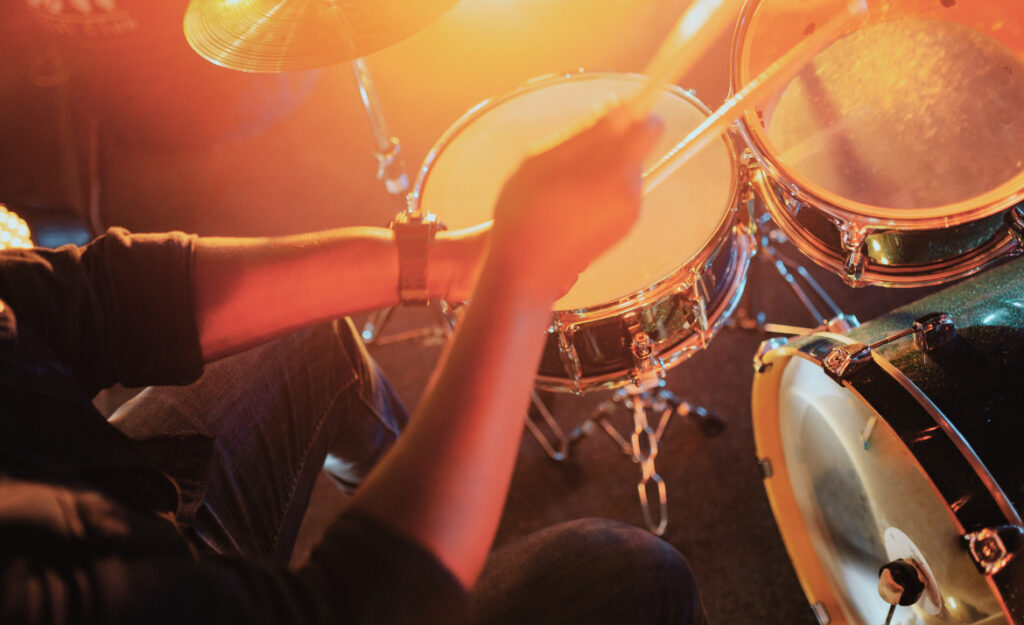Saturated sound on stage can quickly muddle your music. When bands tune into live drum dynamics, the difference is night and day—a performance that breathes, blends, and genuinely connects with audiences. Finding that balance starts with the drummer and spreads to every instrument.
Musicians know volume wars can ruin a show. Crowded frequencies, clashing tones, and overbearing drums drown out nuance, harming both energy and clarity. Avoiding this trap is essential for everyone, from the kit to the crowd.
With the right mindset and practical steps, any band can create space and presence by shaping their live drum dynamics. Let’s dig into field-tested tips and habits that work on real-world stages of all sizes.

Dialing in Drum Volume as a Foundation for Clarity
Setting consistent drum volume is the first move for tighter band performances. By tethering drum levels to the stage—not just “playing louder”—the entire group can finally blend together and avoid chaos.
Picture a soundcheck where the drummer starts quiet, then gradually increases their hits while the band listens from various spots. This eliminates surprises during set changes and gives the group a baseline for every song.
Listening Exercises That Reveal the Real Room Sound
Invite a friend or bandmate to walk the space as you play, checking for dead zones and hotspots. Have them signal when snare or kick becomes overbearing. Note where balance holds and where it falls apart.
If possible, record a short passage using a smartphone, then do a play-back through a PA system at show volume. This exposes masking issues and lets everyone hear whether the live drum dynamics are supporting or smothering the mix.
Try swapping seats for a song: let the guitarist or singer sit at the kit while the drummer walks the room. This builds empathy and sharpens focus on group balance—increasing awareness instantly.
Setting a Drum Volume Reference with a Decibel Meter
Invest in a low-cost handheld decibel meter to spot-check levels. Set an agreed target for peak snare and kick based on room size and style so each show starts with common ground.
Have the drummer play a typical chorus groove while others read the dB level front and center. Mark the threshold that works; refer back before every set to curb drift, especially when stage adrenaline runs high.
Save these dB reference points for future gigs. By recording your results, you can adjust easily for new rooms and reduce extra stress on the fly.
| Drum Element | Target dB Range | Common Pitfall | What to Adjust |
|---|---|---|---|
| Snare | 90–100 dB | Piercing, harsh mids | Hit with more wrist, less arm force |
| Bass Drum | 88–98 dB | Muddy low end | Feather pedal or swap beater |
| Hi-Hat | 84–92 dB | Chatter, over-ringing | Raise cymbal angle |
| Toms | 88–94 dB | Peaks overpower guitar | Dial back fill intensity |
| Cymbals | 88–96 dB | Washed-out song transitions | Use lighter sticks |
Tuning and Touch: Building a Responsive Drum Setup
Every drummer shapes the band’s overall sound by how they tune and strike their kit. Fine-tuning heads and surface choice sets up the entire group for successful, balanced sets.
Think of the drum kit’s responsiveness as a conversation: tight heads, lighter sticks, and thoughtful placement draw out detail and studio-level control, making it easier for the rest of the band to follow and complement.

Audience Engagement Tricks Every Drummer Can Use
Learn practical audience engagement tricks tailored for drummers.Head Tension for Control, Not Just Power
Low, floppy heads generate volume but sacrifice control and richness. Tune snare and toms evenly, aiming for a melodic pitch rather than only “thud.” This keeps transient peaks in check for better live drum dynamics.
Clear, controlled heads highlight every ghost note and articulate fill. Teams that rehearse with consistent head tension discover it’s easier to make subtle live changes and fix problem frequencies immediately.
When sound techs know your drum surfaces are always reliable, they’ll trust your self-mixing instincts and offer more freedom during the mix.
Choosing Drumsticks and Cymbals for Blending
Select lighter sticks for sets heavy on vocals or acoustic instruments. These sticks retain crisp attack without drowning other players; this subtle swap can be the difference between dynamic synergy and onstage clashing.
Thinner, darker cymbals run less risk of overpowering mixes or masking stringed instruments. Drummers who adjust cymbal selection for each session stay responsive to both the room and group needs.
Develop a habit of pausing before each song, glancing at the sticks and cymbals in play. This encourages proactive, intentional shifts rather than reactive, “louder is better” habits.
- Pull out lighter sticks for quiet rooms and nuanced parts, gradually increasing size as rooms fill up or genres change for clarity without overwhelming.
- Keep a set of moon gels or dampeners handy—apply quickly to control ringy or boomy heads and maintain clear, punchy tones even when switching tunings between songs.
- Arrange cymbals at an angle that prevents excessive rebound and ensures your stick attack remains precise and not overly forceful, boosting overall articulation.
- Double-check pedal action on hi-hats and kick. Responsive pedals allow subtler variations and prevent fatigue-induced volume spikes halfway through energetic gigs.
- Test head types before each rehearsal—clear for attack, coated for warmth—and take notes on which combination gets the best band feedback, then standardize accordingly.
A band that shapes their setup around musical needs—not just personal habits—sets the stage for reliably controlled, punchy sets every night.
Room Acoustics Impact Drum Choices
Rooms with lots of reflective surfaces amplify drums unnaturally, masking softer instruments. Position the kit so that hard walls aren’t directly behind, or try using portable baffles.
Monitor yourself in headphones or through wedges at practice to simulate the effect of an echoey room. Adjust touch, attack, or muffle gear as needed for best live drum dynamics.
Ask bandmates for live feedback after soundcheck in different venues. Quick swaps—a towel over the snare, cutting ring from floor toms—can prevent volume trouble before shows start.
Coordinating Group Dynamics with Verbal and Non-Verbal Cues
Live drum dynamics improve group coordination when drummers and musicians use practical cues. Proactive band communication shapes groove, space, and balance, giving each instrument clear moments to shine.
Establishing go-to cues avoids confusion if a song’s volume or feel unexpectedly shifts, so everyone can stick together without pausing or huddling mid-set.
Agreed Visual Signals Keep Everyone Synchronized
Work out band-specific gestures before shows: drummers raise a stick before a dramatic drop, or lock in eye contact before a chorus ramp. Reliable cues minimize mistakes and keep transitions musical, not jarring.
If a section calls for bringing the intensity up, drummers might nod in time or “count-in” with a stick click overhead—these actions tell bandmates exactly when to join the lift.
For breakdowns or quieter parts, hold up a hand to shift to brushes or swap to rods. This solidifies changes and helps the rest of the band adjust instantly without words.
On-the-Spot Dialogue for Dynamic Adjustments
Mid-show, call short phrases into your mic like “back me off” or “more snare” when monitoring stage volume. Drummers who speak up confidently maintain groove and communication even if techs can’t hear everything.
Leaving a rehearsal with 2-3 agreed phrases, like “ride out” or “drop low,” eliminates stalling and guessing when shifting live drum dynamics on the fly. Each player knows what action those words prompt.
Trust-building through consistent practice smooths out nerves and keeps the entire group locked in during energetic or unpredictable gigs—one cue can steady the entire room.
Shaping Groove, Space, and Energy with Dynamic Variations
Building grooves that breathe lets each instrument have its moment. Purposeful dynamic shifts guide listeners and shape emotional arcs; bands that master this flatten the learning curve for every new setlist.
Drummers can map out energy arcs by marking sections for soft, medium, or hard hits. Discussing these arcs during rehearsals builds group memory and strengthens performance flow.
Dynamic Micro-Sectioning within Songs
Divide complex songs into digestible blocks: an “introduction” with brushes, “verse” with light groove, “chorus” with open hats and deep snare—this creates organic builds instead of surprise jumps.
Write shorthand notes in your chart: “v low,” “c big crash.” Practice these micro-transitions with the rhythm section until everyone reacts to each change instantly without looking at one another for cues.
If someone loses track mid-song, tap your sticks against the hi-hat for three beats at the lower dynamic. That brief audible reset restores confidence and gets everyone back on course.
Spacing the Kit for Maximum Nuance
Spread drums and cymbals so ghost notes and off-beat accents are audible to the group, but don’t move them too far where reach feels awkward or unnatural. Small tweaks unlock ear-level musical details.
Arrange dampeners on drums and cymbals that frequently blur together in your genre. Each change should create a ripple among other musicians—if their playing becomes more expressive, it’s working.
A drummer in a funk band might tilt the snare for rapid ghost notes by the lead vocal, while a rock group tightens ride cymbal placement for brighter, cutting patterns in a loud club setting.
Developing Onstage Habits That Promote Balance
Consistent live drum dynamics come from intentional onstage habits. Drummers and bands who apply deliberate steps each gig deliver clear, balanced sets that keep audiences engaged and returning for more.
- Warm up with soft sticking exercises. This fine-tunes sensitivity to smaller motions, ensuring you don’t default to max volume when nerves hit.
- Check your own monitoring channel before every set. Too much drums in your mix can tempt you to overplay—aim for just enough to lock in, not dominate.
- Verbally confirm volume expectations before the first song. Let others know if you expect to shift intensity midway, which helps stave off volume leaps that derail balance.
- Commit to one “quiet run” through the entire set each rehearsal cycle. This flags problem sections and prompts creative solutions for dynamic contrast.
- Log live notes after each show. Quickly jot down which moments felt out of sync or overpowering, then adjust habits or gear for the next session based on those details.
If your band develops routines around these actionable steps, live drum dynamics become second nature, not a struggle between personalities or egos.
Creating a Culture of Feedback and Adjustment at Rehearsal
Musicians who invite honest feedback and adjust their playing build a culture of collective balance. Live drum dynamics thrive when every band member feels invested in group sound, not just personal skill.
Encouraging short, specific feedback bursts after run-throughs unlocks fixes before they become habits. Rotate who leads each rehearsal—guitarist, bassist, vocalist, or drummer—to highlight fresh perspectives and challenge the status quo.

Real-World Checklist for Ongoing Improvement
- Record each set’s loudest and quietest parts; review as a group and pinpoint sections that pushed or lagged.
- Assign one member per show to call “quiet check” mid-set and ensure everyone responds by lowering volume or adjusting groove accordingly.
- End every weekly rehearsal by swapping instruments for a song. This deepens empathy and increases group sensitivity to changes in live drum dynamics.
- Hold a pre-gig huddle every show, committing to one volume or dynamic adjustment for that night—track results and celebrate improvements.
- Structure feedback as “I heard the [instrument] overpower at [song section]”—not blame, but direction for instant fixes next show.
Groups that treat feedback as opportunity—not criticism—build trust, strengthen listening skills, and refine every new setlist.
Bringing It All Together: A Roadmap for Better Band Balance
This guide mapped the real habits and techniques that support professional, balanced band performances. Live drum dynamics sit at the heart of clarity, energy, and listener engagement on every stage.
From practical setup tweaks to coordinated rehearsal feedback, each action fuels steady progress. Attention to detail—whether stick choice, volume logging, or section-specific adjustments—empowers everyone in the band to shine equally.
Sharpening live drum dynamics is a journey, not a quick fix. Embrace each show and rehearsal as a step: experiment, listen, and commit to collaboration. Memorable bands evolve through mindful, musical balance every time they step on stage.



